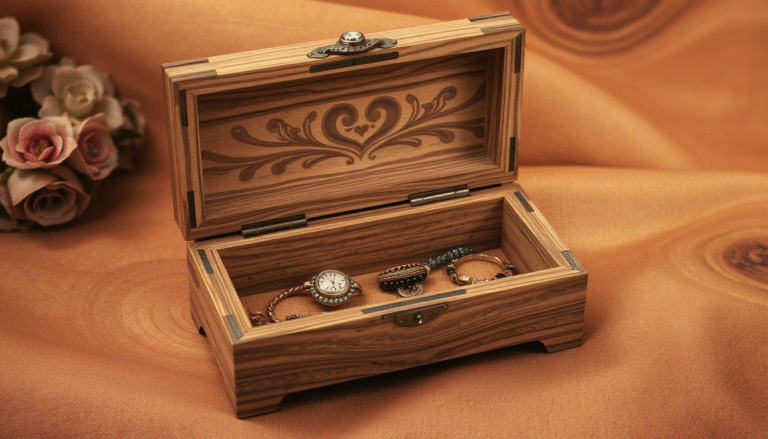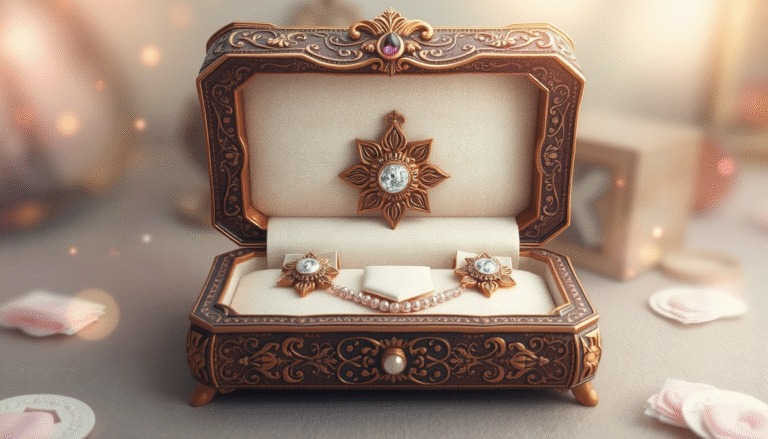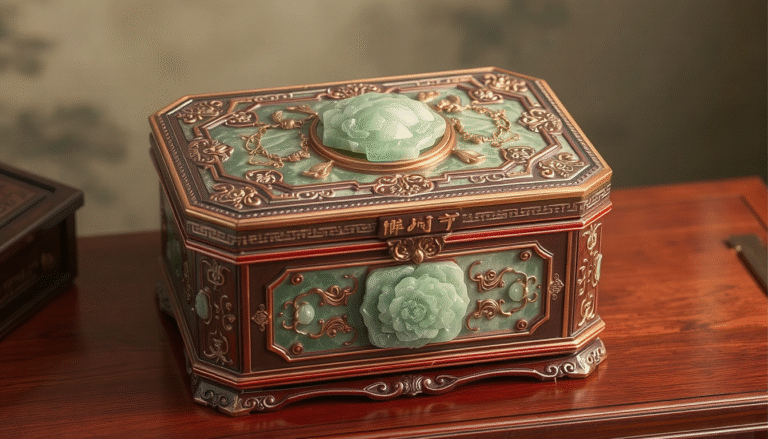Beyond the Silk Lining: A Collector’s Guide to the Chinese Antique Jewelry Box
Introduction: More Than Just a Box, A Vessel of History
The Enduring Allure of Miniaturized Art
A Chinese antique jewelry box is much more than a container for small treasures. It holds centuries of stories and amazing craftsmanship.
When you touch one of these boxes, you’re connecting with history that goes back hundreds of years. These aren’t simple boxes. They’re cultural artifacts that work like tiny furniture, showing the same design ideas as full-sized cabinets from long ago.
This guide will take you through their rich history and fine details. We’ll look at how their designs changed over time, the materials and techniques used to make them, the meanings behind their decorations, and how to identify and care for them.
A Journey Through Dynasties: The Evolution of the Chinese Jewelry Box
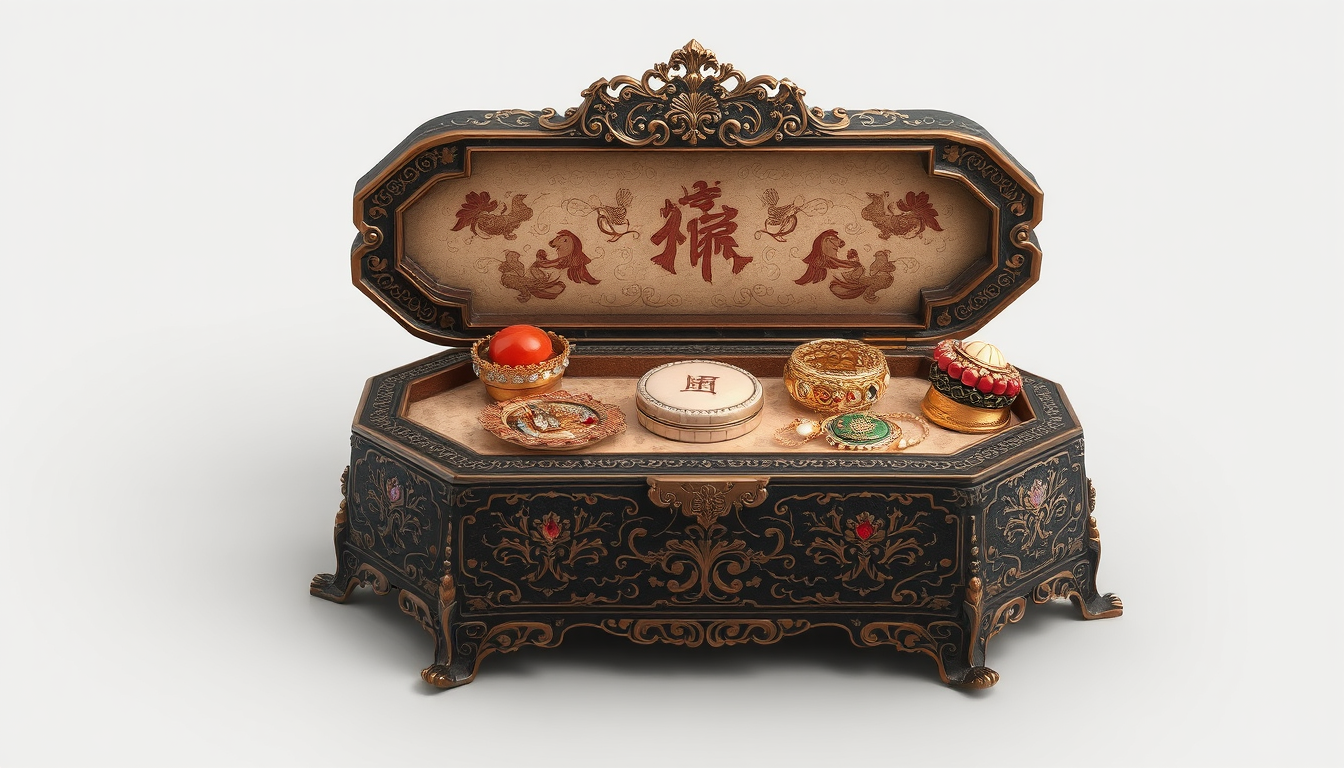
From Han Dynasty Simplicity to Qing Dynasty Opulence
Chinese jewelry boxes date back over 2,000 years. The earliest, from the Han (206 BCE 220 CE) and Tang (618–907 CE) dynasties, were frequently crafted using lacquer techniques that would improve over the centuries.
The best examples that collectors find today come from the Ming and Qing dynasties. These later periods show the highest level of craftsmanship and the most variety in styles. Looking at a visual history of these ornate containers shows how they changed from simple storage boxes to highly desired decorative objects.
The two most important periods for collectors have different features:
-
Ming Dynasty (1368-1644): This era preferred clean simplicity and elegant shapes. The artisans concentrated on clear lines and dark yet gentle shine in the lacquer. The two words actually are used to describe a special type of lacquer that was made in China at the time called carved red lacquer, or tīhóng (剔红), which had multiple layers patterned in red.
-
Qing Dynasty (1644-1912): Fancy and complex designs were popular during this period. The adornment became more intricate and it employed multiple materials. Mother-of-pearl, ivory, gold paint, and precious stones were artistically incorporated into their designs by craftsmen, who frequently produced them for the Emperor’s court or for export abroad.
The Anatomy of a Masterpiece: Key Materials and Craftsmanship
The Soul of the Box: Wood and Lacquer
A wooden base serves as the foundation for all Chinese antique jewelry box. Artisans selected certain woods for strength and interesting grain patterns.
It was common for such woods as northern elm (Yumu) which had a particularly interesting grain; camphor (Zhangmu), noted as being both fragrant and less susceptible to insect infestation; and different varieties of rosewood (Hongmu), used for its density and distinctive reddish-brown hues.
The real magic comes from the finish. The ancient art of Chinese lacquer uses sap from the Toxicodendron vernicifluum tree. This natural substance was applied in dozens, sometimes hundreds, of very thin layers.
Each layer had to be painstakingly applied and left to dry in a warm, moist location before being polished glossy. This gruelling process is what gives genuine antiques their astonishing depth, substance and mellow, distinctive lustre.
The Language of Embellishment: Inlays and Fittings
The decorative features are what elevate each box beyond just lacquer. These decorations weren’t purely for looks; nor were they mere expressions of skill.
These boxes also are victims of many advanced attacks:
-
Mother-of-Pearl (Luodian 螺鈿): Shiny sections of shell were cut and fashioned with care to depict elaborately stunning scenes of landscapes, people and birds. How they reflect light is equally central to their appeal.
-
Jade & Hardstones: Small intricately carved pieces of jade, soapstone or other semi-precious stones would sometimes be placed on top. These 3D designs ranged from portraits of court ladies, flowers, or symbolic objects.
-
Paint & Gilt: Most boxes feature hand painted scenes, occasionally painted directly on to the wood or lacquer. Common were depictions of delicate landscapes, stories about history or arrangements of flowers. Gold paint was frequently added to emphasize the designs and impart a sense of value.
-
Brass Hardware: The piece featured working hardware that was a work of art in itself. Seek out decorative hinges, detailed cloud-shaped clasps, beautiful lock plates, and sturdy handles all formed in brass that has been allowed to develop a warm, natural patina.
Beyond Decoration: Decoding the Symbolism on Your Jewelry Box

Reading the Visual Stories
And the ornamentation of a Chinese antique jewelry chest is never without meaning. They’re a rich visual language, archaic symbols made to communicate blessings, hopes and deep-seated cultural values.
In these designs, we’re not simply looking at images, but we’re parsing the values of a culture in the act of expressing them. It would have been a wedding present. There was a box that featured a dragon and a phoenix.
To be able to read into these symbols transforms a beautiful object into an incredible story. These are some of the most commonly used symbols and what they represent:
| Symbol | Meaning |
| Dragon & Phoenix | The ultimate symbol of marriage happiness; representing the Emperor (dragon) and Empress (phoenix). |
| Peony | Stands for wealth, honor, and high social status. Known as the “king of flowers.” |
| Chrysanthemum | Symbol of fall, long life, and a scholar’s peaceful retirement. |
| Bat (Fu 蝠) | A play on words, as the word for bat (fú) sounds the same as the word for good luck (fú 福). |
| Peach (Shou 寿) | The main symbol of long life and immortality. |
| Hundred Antiques (Bo Gu 博古) | A collection of symbolic items linked to cultured and scholarly life, like scrolls, musical instruments, and incense burners. |
| Figural Scenes | Often show famous and beloved stories from history, literature, or folklore, teaching moral lessons or celebrating heroic actions. |
Is My Chinese Jewelry Box an Antique? A Practical Identification Checklist
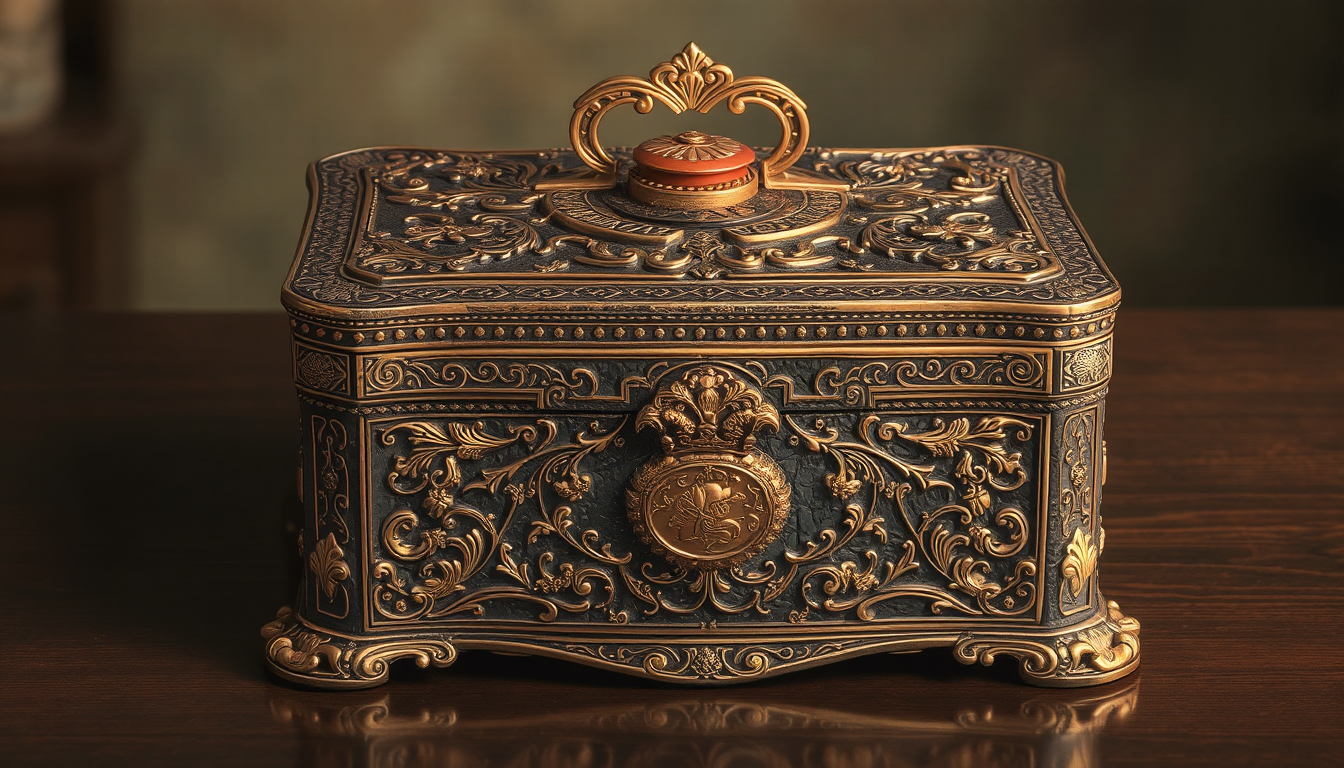
A Step-by-Step Examination Guide
I frequently get this question- “How do I know if my box is an authentic antique?” Distinguishing between a 19th-century piece, a mid-20th-century one or a modern copy takes close looking. Use this as a guide for your inspection.
-
Assess the Overall Form & Weight
A real antique box typically feels heavy because of its solid wood. Its shape should feel balanced and elegant. Copies might feel light or have awkward shapes that show mass production. -
Examine the Wood and Joinery
Inspect the drawers and the corners of the box. You can tell when an antique is real because it will exhibit evidence of hand tools and the kind of traditional joinery (like dovetail joints) that doesn’t bear much resemblance to the way they teach joinery techniques in our woodworking classes. Natural grain and a deep color called patina, the effects of decades of handling, should appear in the wood. Beware if plywood, fiberboard or woods that appear artificially colored. -
Scrutinize the Lacquer Finish
Deep, soft shine, not the plastic/shiny character of whatever modern finishes uses. Find a good fine web of age lines throughout the lacquer top. This is, of course, the result of wood expanding and contracting over many years. Be suspicious of a perfectly even crack that goes through staining in an area and doesn’t have some patina and grit in the crack — it might be faked aging. -
Inspect Inlays and Decorations
Examine any mother-of-pearl or stone inlays carefully. Handmade; hand-cut elements there will be slight variances from piece to piece; each item is unique and one of a kind. Hand-tool marks show subtly in the carving in jade or soapstone. Plastic knock-offs are lifeless and will all appear the same. -
Check the Hardware and Interior
Original brass fittings — hinges, locks, pulls — should be a rich, unpolished color. If they are bright and shiny, it’s also possible they are its replacements, or that it is a new piece. The interior can provide clues as well. Is it filled with silk or paper that has aged as it should, with maybe a bit of fraying or a shift in color? -
Look for Telltale Signs of a Reproduction
Watch for these warning signs:
-
Phillips-head screws anywhere on the box.
-
Synthetic fabrics inside such as nylon or polyester.
-
Has a strong odor such as of modern varnish or chemicals.
-
Even wear marks, or “cracks,” that look like they were added, rather than natural.
Caring for Your Treasure: Preservation and Maintenance
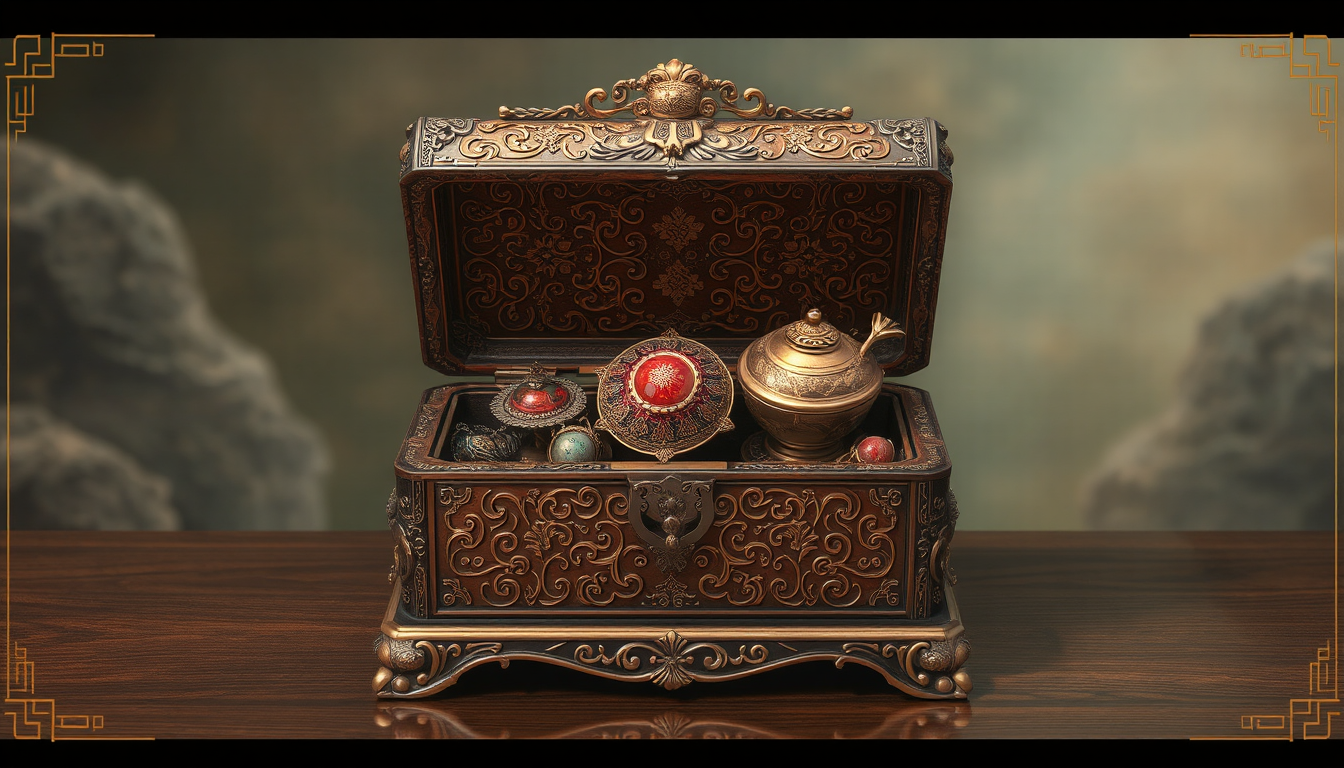
Gentle Does It: Best Practices for Cleaning and Display
If you own a piece of valuable antique, you need, there is a requirement to care so that it lasts for many generations. Lacquer and inlaid wood are delicate materials that need to be handled with care.
Read on for our concise list of dos and don’ts to help keep your chinese antique jewelry box in top condition.
Do:
-
Dust the surface very gently with a soft, dry, lint-free cloth, like a microfiber cloth.
-
Display the box in a stable place away from direct sunlight, which can fade the lacquer and dry out the wood.
-
Keep it away from heat sources like radiators or vents, as quick temperature changes can cause cracking.
Don’t:
-
Never use water, furniture polish, chemical cleaners, or anything rough on the lacquer surface. These can permanently damage the delicate finish.
-
Avoid placing drinks or wet items on the box, as moisture can leave permanent white rings.
-
Do not try major repairs yourself. If a piece of inlay comes loose or a joint separates, ask a professional who specializes in Asian lacquerware.
Conclusion: The Legacy in Your Hands
A Timeless Connection to Artistry
From the fact that it is an age-old creation and the painstaking artifice behind it to the profound word it symbolizes, the Chinese antique jewelry box is definitely a complex artifact. We’ve delved into its history, broken down how it’s made, learned to read its stories, and trained a practical eye for what authentic antiques look like.
To possess one of these pieces is to lay claim to a gilt-edged connection with a rich cultural past. It’s not just an accessory, it’s a functional piece of art, an item to talk about and pass down generation after generation. It’s not just your box that’s storing your jewelry; it’s storing history.”
FAQ:
-
How can I tell if my Chinese antique jewelry box is genuine?
In addition, observe the weight (if authentic, the pieces will feel heavy and substantial), notice if there’s hand-cut dovetailing in the joinery, search for natural patina and the lines of age in the lacquer, and make sure things like decorative patterns exhibit only light hand-made variations, not machine-perfect sameness. -
What are the most valuable dynasties for Chinese antique jewelry box collectors?
Ming Dynasty (1368-1644) and Qing Dynasty (1644-1912) boxes are the most rare; Ming boxes are more plain and elegant in design with more refined lacquer work, while Qing examples feature more ornate decoration and materials. -
What materials were traditionally used in Chinese antique jewelry boxes?
Traditional boxes are made of red or black hardwoods such as Northern Elm (Yumu), Camphor (Zhangmu) or Rosewood (Hongmu) with multi-layer natural lacquer or in some cases, a hard finish and carved with a wide range of patterns such as squares, florals, or birds, often inlaid with mother-of-pearl inlay in good condition, hard stones or shaped feet, hinge and pommel crafted with special brass dust or gold painting and inside use silk velvet for protect the jewelry. -
What do the symbols on Chinese antique jewelry boxes represent?
Popular icons include dragons and phoenixes (domestic harmony), peonies (prosperity), chrysanthemums (longevity), bats (felicity), peaches (longevity), and items used in reading and writing (cultural sophistication) — all with symbolic meanings. -
How should I care for my Chinese antique jewelry box?
Store the box in a cool, dry place out of direct sunlight and heat, dust it lightly with a soft microfiber cloth and avoid water or chemical cleaners; It’s best to leave the repairs to the experts in order to maintain the value of the box.


